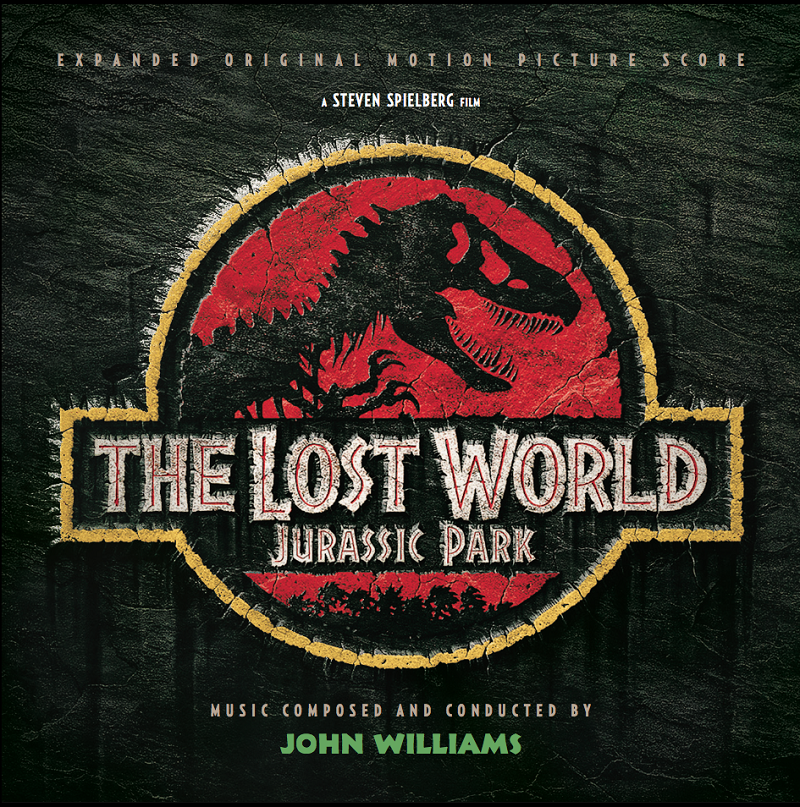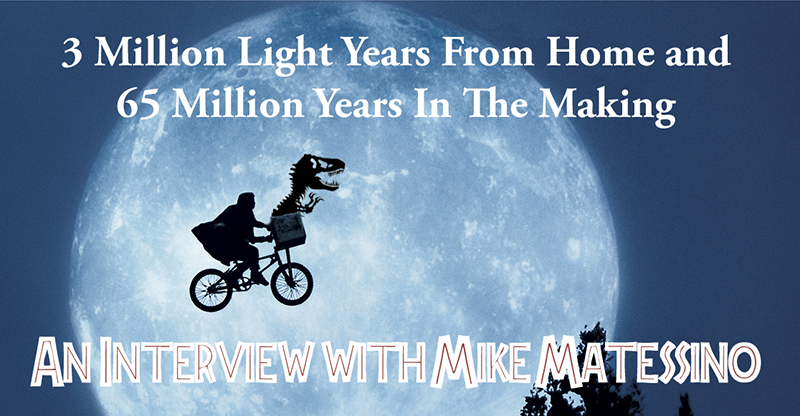 By Jason LeBlanc
By Jason LeBlanc
Mike, thanks for joining us again! The last time we talked was for three big John Williams score expansions – Jaws, Jaws 2, and Home Alone – and now less than 2 years later, three new Williams/Spielberg score expansions are already out, with one more imminent, and I think there’s some interesting details to dive into for each one, so let’s begin!
I should start by noting that you’ve already been interviewed about The John Williams Jurassic Park Collection in episode #77 of The Jurassic Park Podcast hosted by Brad Jost, and I strongly recommend to everyone reading this to listen to that great interview first, as so many topics concerning the collection, including how the release even came to be, are covered there.
Thanks. That was fun. I did a podcast about the animated Star Trek immediately before that on the same day.
One of the most surprising pieces of information from the podcast was that the original 1/2″ stereo masters for The Lost World were found to be deteriorating when they were pulled for this release – they were less than 20 years old at the time! You indicated that 1” stereo masters were used instead. Can you explain the difference between these storage methods, and how the final product might have been different – if at all – if the 1/2″ masters could have been used?
The 1/2” tapes have unmastered stereo mixes on them and the 1-inch tapes have the 5.1 mixes. When folded down those would be basically the same thing, but using the 5.1 gave me a bit more ability to hear precisely how it was imaged. I didn’t use the surrounds but I listened to them as a reference. I didn’t really have to do much to it; it was such a great recording. I’m not sure why the 1/2” was shedding. That’s the unpredictability of analog tape. It’s organic material.
Unlike many of the recent Williams/Spielberg score expansions, The Lost World never had an earlier expanded score release – this was the premiere release of any music not from the original album. Is there generally more or less work for you to do when working on a score that hasn’t already had an expanded score presentation released compared to a score that has?
The level of work is mainly determined by the condition of the material. Assuming it’s in good shape, then there is generally more work if there has been a previous expansion or other material in circulation, because I will always check those out and compare everything to it. If no one has ever heard a score, then the concern about changing it or taking something away that’s already out there isn’t a factor. On E.T. I spent at least four full days comparing the three CDs and LaserDisc track and two mixes of the movie to each other months before I had any new transfers to work with. So the more material has been out there before, the more “reverse engineering” has to be done. It’s much simpler if you just have one mix of the film and an original album.
Large amounts of The Lost World’s score went unused in the final cut of the film, and it was pretty illuminating to learn in the podcast how you would listen to clues from stage chatter preserved on the master recordings for what changes Williams might be looking for from take to take when you were selecting which takes to use for unused music included on the collection, since there wouldn’t have been film or album to compare takes to. Is this something you’ve gotten better at doing, the more of these projects you’ve worked on?
I would say, in all humility, that my instincts have been sharpened. It happens with any type of work one does for an extended period. Basically you have to look for clues wherever you can, so if some specific bar is mentioned in the session chatter, it’s worth checking out the printed scores to see what’s going on there. I don’t know that making that extra effort amounts to anything for the average listener, but my philosophy is that anything worth doing is worth doing correctly. Williams is very specific about the selection of takes and intercutting, and there have been far too many incorrect performances put out over the years on various scores.
The cue “Ripples” was heavily edited in the final cut of the film, featuring some sections looped and moved around and some music appearing that isn’t in the cue recorded by Williams that appears on the new CD. Did you study the film version at all to determine where that music might have originated from?
I didn’t have a clean music stem (like I did on A.I.) so that I could hear what was going on without the sound effects, but I’m certain it was created editorially. In fact, that cue was recorded on the first day of the sessions and the logs don’t show that they ever went back to it for anything. There weren’t any cues recorded that I didn’t include. As we all know, that score underwent a lot of editing for the released version of the picture.
For mastering the final program of The Lost World once it was assembled, there was no previous expansion to compare to, only the original album. Did you follow Patricia Sullivan’s lead from the 2013 Jurassic Park 20th Anniversary Edition as a guide to how The Lost World might be mastered for the current market, or did you follow a different methodology?
I mostly referenced my own Jurassic Park master because I worked on that one first and I knew that the two would be released in the same set, so for The Lost World I just went with what I thought sounded best. And again I didn’t really need to do anything other than make sure what was already there in a great recording was allowed to shine.
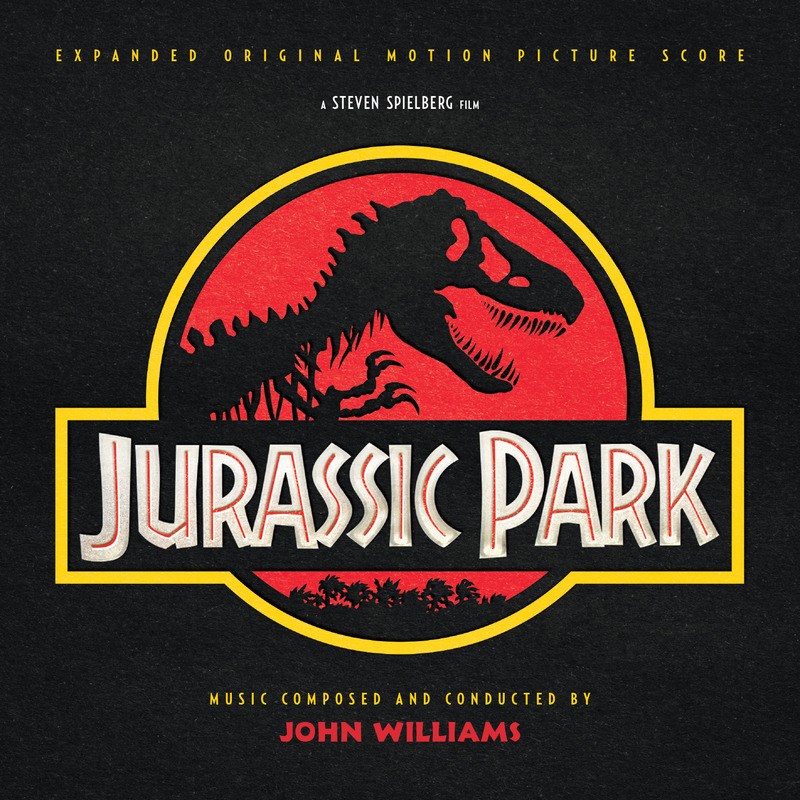
Like The Lost World’s 1/2″ stereo masters, the original multi-track elements for Jurassic Park were also found to be deteriorating when you were looking for shakuhachi flute and choir elements for the Live to Projection concerts. You didn’t need the multi-tracks for the new collection, but I just wanted to thank you for ensuring that the multi-tracks were digitally preserved! It can be shocking how quickly analog elements begin to deteriorate, and your continued work in the field ensures that so much important music gets preserved digitally before the original elements are gone forever!
Thanks. I don’t know that 24 years can be considered quick. It just doesn’t feel that long. Jurassic Park opened in 1993 when I was just starting to work on The Sound of Music, and 24 years before that would have been 1969, so it’s all relative. On Jurassic Park, they had to bring in all the rolls even though I was just looking for a couple of cues, so it made sense to transfer them since they were all just sitting right there. I’m very happy Universal saw it that way too. It was interesting to actually see the track sheets and to also put up the rolls we did because it illuminated just how much synthesizer is in the score all the way through. When I was checking out the choir for the scene where we first see the dinosaurs, we heard synth going all through that. I raised the issue for the live concert and did propose embedding the synths from “Dennis Steals the Embryo,” but they ended up just revoicing everything and also using a synth choir. The shakuhachi is the only thing from the multi-track that is used in the concert.
The original scoring session elements were already transferred in 2013 for the Jurassic Park 20th Anniversary Edition, so did not need to be transferred again. Since Ramiro Belgardt had already reconstructed the original album with those transfers for Jurassic Park 20th Anniversary Edition, did you piggyback on any of his work, or start all over from scratch?
I started with Ramiro’s sessions, but as you say he was rebuilding the original album. However, his reference was a rip of the 1993 CD, which was, like many discs of that era, not at the correct speed. It didn’t look like that was accounted for, so in some places the edits did not seem precise to me even though they were okay technically and musically. Some cues were fine as they were but on many others I made sure that they were precisely aligned, right down to the sample, so the edit points were adjusted. I also kept the same intercuts that were originally selected and cleaned up noises on the tracks rather than going to different takes. I wanted to stick with the performances that were chosen at the time.
Was there any thought given to reconstructing the Jurassic Park soundtrack album again for the La-La Land release since there was room for it?
No, because it wouldn’t have felt right to do that for Jurassic Park but not for The Lost World, where we didn’t have the room. And the feeling was that there was already a place to go for a remastered version of the original Jurassic Park album.
Jurassic Park is notable for featuring some cues conducted by someone other than Williams – Artie Kane helped with with conducting as Williams was recovering from a minor back ailment. Was it clear once you had access to every take of every cue which were conducted by Kane, and which by Williams?
Yes, because you could hear Artie doing the count-in and talking with the orchestra or to Shawn Murphy in the booth. On some of the sessions he conducted, Williams was in the booth anyway. Artie conducted on three sessions, so basically a day and a half.
You share an interesting story on the podcast about how “The Falling Car” moved around in the program a few times based on discussions with Williams. How important is chronological order and listening experience to you when working on these Williams scores, and how does it compare to working on scores by other composers?
I think it’s fine to start with a chronological presentation as a default, but it really depends on the score as well as the administrative details of a particular project. On Edward Scissorhands, for example, I combined short previously unreleased cues together even though it broke from chronology. This was because there was a long cue that came in between them that was on the original album. So from a licensing and publishing standpoint that makes life easier and it often results in a better listen. There are definitely projects where I now feel I should have diverted from chronology in just a few spots for listening purposes. As long as all the cues are included, I think that listeners appreciate when adjustments make sense for the musical experience. If you just line up cues in order, then you’re making a museum piece, not an album. It’s certainly a valid approach, and the one most labels follow, but every so often there’s a good reason to make a change.
I have begun to sense lately that there is a greater interest in having a good listening experience rather than just collecting an inventory of cues. But in the case of “The Falling Car,” I remember discussions back in the day among fans who were discovering film music through Jurassic Park and noting that the cue was at the start of the album rather than where it belonged. I personally prefer it to be in sequence because of the way the score is structured, but since there are no themes in the cue there’s a valid argument that it gives the album more of a ‘bang’ opening.
Are there any remaining stories from Jurassic Park or The Lost World that you haven’t gotten the chance to tell anywhere yet?
I can’t think of any, but for the record I’ll just point out that the director looked at the art and didn’t notice the missing teeth. The Collection was a very satisfying project and I’m looking forward to seeing the first movie in concert.
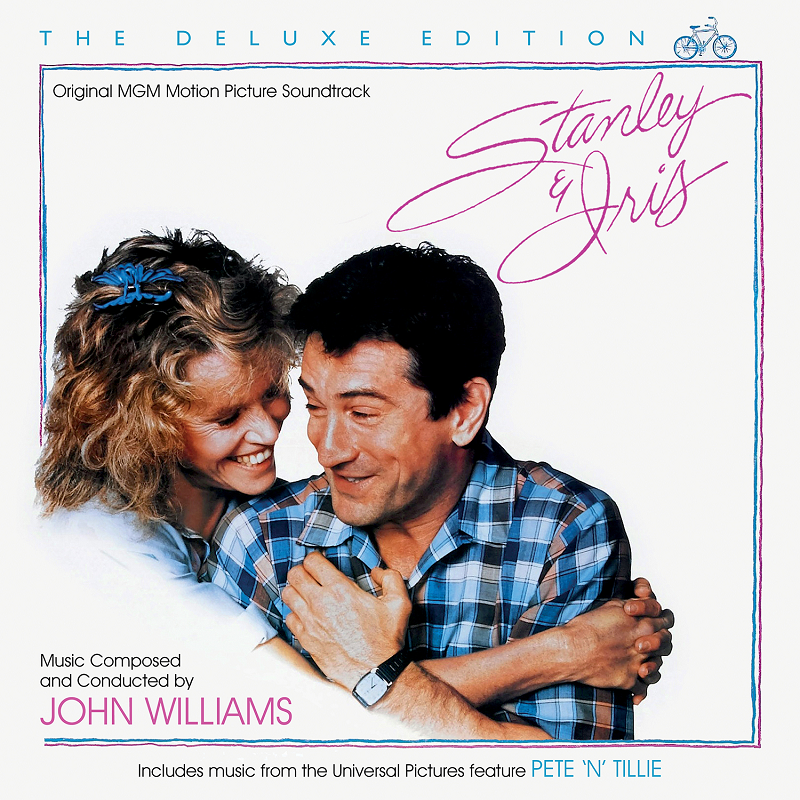
Before we move on to E.T., another reissue you did this year is Stanley & Iris for Varése Sarabande, which included Pete ’n’ Tillie as a nice surprise! How did that release come together?
The impetus for that project was that Twilight Time was going to release the movie on Blu-Ray. So I arranged with Bob Townson to do the album and the two companies split the cost of transferring the masters. We had both stereo and three-track material. For the most part the latter sounded better except on a couple of cues. I got the idea for Pete ’n’ Tilllie while I watched the movie as part of doing research for the liner notes, I just suddenly got the idea and thought there was no harm in trying. As I was already dealing with Universal regularly it was simple to inquire if there were music elements even though there wasn’t much score in the film. The tapes existed but there was a process to getting it added to the release. I thought it might work because Varése had perpetuity rights to Stanley & Iris and had also done Universal titles through their CD club series, including Family Plot and Midway. Townson thought it was a good idea so then I went to Universal and MGM to see if they could find a way to make this work administratively. At the same time, I presented the idea to Williams and I was told that he would have to hear the material first. So that meant spending the money to transfer and evaluate it speculatively. I was pleased to find out that it was in genuine stereo and that more had been scored than had been used in the film, close to 20 minutes. So I submitted it and Williams said yes, and then I worked on polished mixes and took them to Pat Sullivan, who had already mastered the Stanley & Iris portion of the program. The amazing thing is that this all happened within a one-month period, from getting the idea to having a master done and everything approved. Everyone stepped up to push it through so that we could make the release date. It was a real victory because there wasn’t enough of that score to have a release on its own and this was the perfect opportunity for it to see light of day after 45 years. It’s a wonderful theme and a great little gem. People should be aware, however, that if the release sells out Varése would have to re-license that score and they could very well decide to reissue Stanley & Iris, which they own, without it.
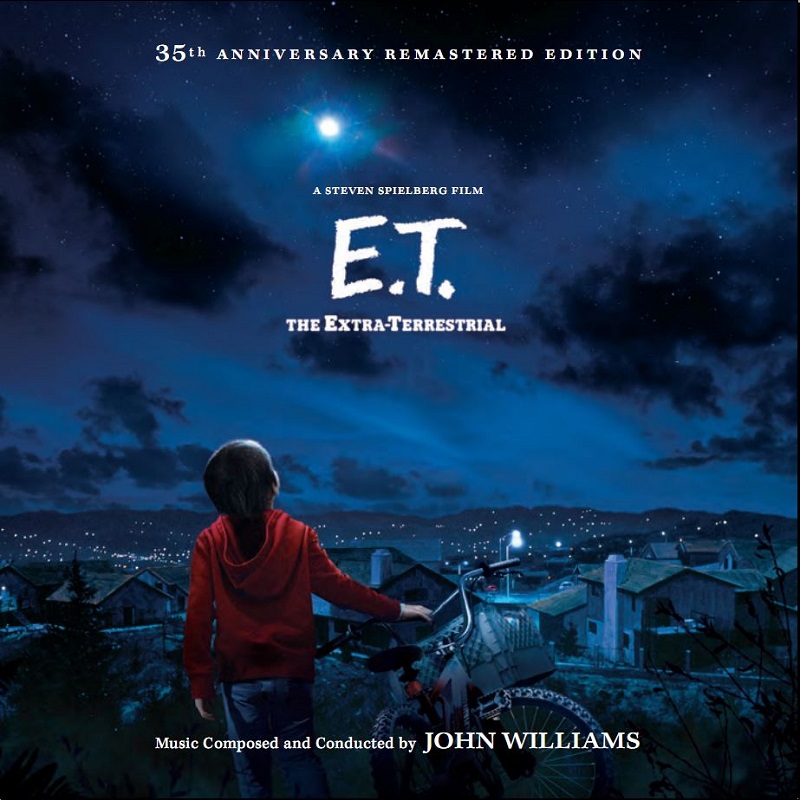
All right, that brings us to E.T. How did this release come to be?
It was in the works for a long time. Universal Music Group was initially interested in doing a new version themselves, for which I was to be engaged. I did some preliminary work looking into elements but then months went by and the project wasn’t getting started. Finally, right as Jurassic Park was coming out I was told that it could not be done internally after all and that they were prepared to offer it to La-La Land under the same terms as Jurassic Park. From there I began the process of calling in the materials to transfer.
How did Bruce Botnick become involved in this release, and what improvement did the new digital transfer of the original session elements have over the sources used for the 1996 and 2002 CDs?
Bruce has always wanted to revisit this recording and as I have done many projects with him I wanted to do this with his involvement since he was co-producer of the original album. In a way this was a companion release to FSM edition of Poltergeist that we did. It was all about getting the quality and the accuracy as well as presenting everything comprehensively. We did E.T. in the same way we did Star Trek: The Motion Picture … first generation elements at 192k hi-resolution and we resolved the sync so that the speed is precise. He made sure that Universal used the best analog-to-digital converter. It may be that a casual listener doesn’t notice a difference, but it’s there. The sound is crystal clear and robust.
I also discovered, to my surprise, that only six tracks on the previous releases were accurate in terms of performance. So for the first time the score will be presented with the correct performance. Knowing the film as well as I do, there is a difference psychologically or perhaps subconsciously. One difference between E.T. and Star Trek, though, is that there was never a multi-track element; the score was recorded as a live 3-channel mix plus a mono surround straight to mag and 1/2” tape.
“E.T. Is Alive” and “The Encounter” were taken from backup 1/2″ 3-channel scoring masters as opposed to the first-generation 35mm 4-channel masters used for everything else. What happened with these two cues?
Both are technically first generation, but the mag is simply a richer and quieter element. The needed take of “E.T. Is Alive” had been spliced out on the set of mag rolls, either because that cue was going to be on the album, or because it was tracked in over “Toys,” or perhaps both. We did have the music dubbing units, which was a separate set of 35mm mag used to mix the film, but on those rolls that cue was already edited together to match the picture, and, in fact, that’s what they used for the 2002 CD. Interestingly, when I checked to see if I could use the “Toys” scene to piece it all together, I discovered that the original “Toys” cue was still on those units, which means that change was made very late. So we went to the 1/2” for the needed takes of “E.T. Is Alive” and that’s when I discovered that there was an intercut in the film that wasn’t done for the original album (on which the track was called “E.T. Phone Home”). “The Encounter” was uncut on the 1/2” and it’s a bit longer than what was on the dubbing unit, so that’s why we used the 1/2”.
The cues “Main Titles” and “The Encounter” are pretty unique compared to the rest of the score; Were they recorded at the same time as everything else?
They were done with two players at a separate session at the very end along with the tinkling E.T. “magic” overlays. We didn’t find mag for this session (other than the dubbing units), so they may have only ran 1/2” for those and then dubbed them over. And that’s why they were missed for the 20th anniversary reissue mix and the prior soundtrack releases. The “Main Title” came from the dubbing unit mag. “The Encounter” wasn’t really a “cue,” per se. It was just wild material recorded after the “Main Title” and was called “Steven’s Gong.” Spielberg may have been the one performing it. In postproduction Kenny Hall just grabbed it and tried it over the scene and Steven liked it. Both cues are just listed as “Alternate Beginning” on the cue sheet.
Did you consider moving both these cues to Disc 2, leaving room to include “The Kiss” and “Levitation” on Disc 1?
I did, and probably would have, had the “Main Title” not been on the 2002 release, because I don’t really feel that it or “The Encounter” are essential to experience of the music on its own. They’re really just atmospheric effects and they’re not even played in the live concerts. But the last release started with it and I thought we should maintain that because having them close together doesn’t really work all that well. It couldn’t all fit on one CD because La-La Land has found that discs can have problems in certain players when they’re over 79 minutes, so 78:59 is their maximum. I thought of adding “The Kiss” to disc 1 anyway since it’s in the movie, but it’s partly source music and once I had “Levitation” it was clear that both of those tracks worked better if they were next to each other. As usual, fans can make their own playlists easily, but I think that the way it turned out it’s a great listening experience as it is. It’s kind of like getting three different versions of a score presentation.
“Adventure on Earth” was one long 15-minute track on the 1982 album, and remained that way on the 1996 and 2002 CDs. How did it come to be split into two tracks for the new edition?
A few reasons. Firstly, the mechanical rate goes up on a track that’s more than 10 minutes now. Publishers have gotten wise to labels dodging mechanicals by making their tracks long. Secondly, the cues were overlapped on the 2002 release and I didn’t want to risk getting asked to do that again if it came up. I could have argued that the cues were separated on the original album, but it seemed easiest, in light of the publishing issue, to circumvent the potential hiccup altogether by just making “The Departure” a separate track. Musically I think it’s something that is good to facilitate easy access to anyway, especially since there’s an alternate version of it on disc 2.
Did you consider using the original cue titles rather than the ones that were created for the 1996 and 2002 releases?
Yes, but it might have been a bit confusing for the consumer, and it would have been more difficult administratively with UME. There are titles I’m not crazy about, but what counts is the music.
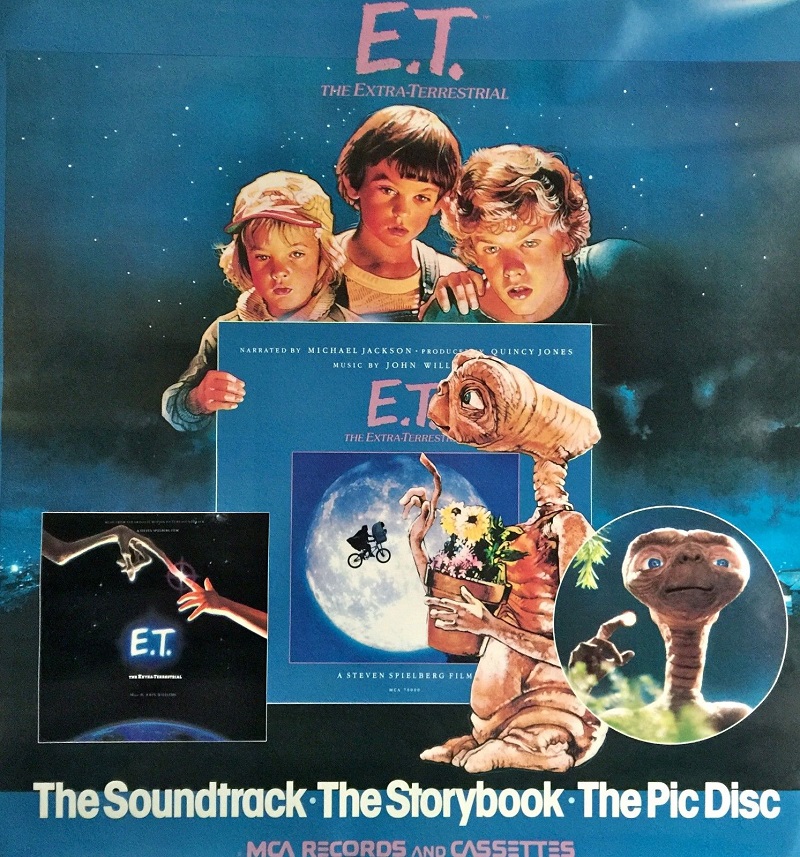
Is there any difference between the remastered original album in this new release, and the one in the new 4K Blu Ray box set?
They are identical. I literally took the finished mastered file for our disc 2 and chopped out everything that followed the original album, made a new file and uploaded the master to UME’s plant. Universal Home Entertainment was looking for something to add to their gift set release and I suggested that and connected them with Universal Music Group to make the arrangements. After that album has been out of circulation for so long it seemed a good way to get it out there again.
The original album is famously comprised of only three tracks from the film’s score, and five tracks originating from a special album recording session held almost a month later, with the same crew in the same room and mostly the same performers. Often times with these expanded score releases, you like to utilize the new modern digital transfers of the original elements to rebuild the original soundtrack album from the same premium source used for the main score presentation. However, the liner notes indicate that for this release, a 1/4″ master of the final finished album found at Universal Music Group’s archives in London was utilized. Can you tell us what happened to the original elements for the album recording sessions?
I’m sorry to say that all evidence suggests the elements are gone. Bruce recalls that he ran only digital on the album sessions and that there was no analog. He had two interlocked U-matic 3/4” machines so that he could record 3-channel audio, so that’s what I wanted to find. Bruce remembered finding them at his facility, Pacific Ocean Post, in the early ‘90s and giving them to Steven’s post-production supervisor. So I worked with Amblin to look through their inventory and also checked Paramount and Universal and anywhere Dreamworks material had been moved over the years, and came up with absolutely nothing. When I got the AFM reports for the album sessions, I was disheartened when I saw that they had been contracted by MCA Records, whereas the film sessions said Universal Studios. So that meant that the 3/4” U-matics may also have been labeled MCA Records. I reasoned that if this was the case, then if anyone had come across them in the ‘90s they might have been sent to Universal Music Group, which had a building on the studio lot, which they kept even after they became a separate company in 2004. That building was destroyed by fire in 2008. I could see it from my house and I was heartsick when I heard music elements were kept there. The fire is sometimes used as a convenient excuse when something can’t be found, but in this case I believe that’s where those masters ended up.
Naturally I checked with Universal Music Group as well and they physically looked at everything in their vaults. They found that they had no original album master for E.T. in the United States at all. NONE whatsoever. That meant that a Grammy-winning album, at that moment, only existed on CDs manufactured in the ‘80s. In digging further I learned that with UMG you need to check all territories because the inventories are not merged … so that means inquiring with Japan, Germany and the UK separately. That’s how I located a 1/4” tape in the UK which was used to cut lacquer for the original LPs and make cassettes. We had that transferred at 192k/24bit and that’s what we used. A digital master would only have been at 44k/16bit. The original recording tapes would also have been in that format, but we would have had the material in 3-channel. But without that, and only stereo to work with, we were better off with a hi-res tape transfer than with a 35 year-old digital master that probably would have been full of ticks and dropouts. It was better to use the 1/4” tape all the way through rather than reconstruct three of the tracks but not the other five.
Now that’s a fascinating story; It’s quite remarkable that slightly different notation led to one set of tapes being preserved and one lost to time. That Universal Music fire was a sad day for film music! Since “Stay With Me” was recorded at these album sessions, this means you didn’t have access to every take of this cue, only the final edited take(s) used in the film, correct?
Yes, but the three channel cue had been transferred from the digital master to the dubbing units and there was no edit in it, so that meant they used just one take for it.
Does this mean that all the other alternates were all recorded during the original main scoring sessions?
Yes, those were all part of the main sessions. “Stay With Me” is the only thing heard in the movie that was done at the album sessions.
So for this score, what was recorded analog, and what was recorded digitally?
Bruce is positive that both digital and analog were run for the entirety of the E.T. film sessions with two interlocked 3/4” U-Matic machines recording the digital. The thought at the time was that the digital could be used to create the analog dubs for editing the picture without the generational loss of going from mag to mag. But that didn’t take place. One set of mag was used to cut the picture and a second set remained untouched, which is, for the most part, what we used for the 35th anniversary edition. For the album sessions, Bruce thinks it was just recorded digitally (and possibly as live stereo mixes, not 3-channel) with the exception of “Stay With Me,” which may therefore have not been recorded digitally at all, because by that point they knew what was going to be on the album and the movie was already dubbed using mag. At that point they knew that the album master was going to be created digitally. So all of the digital session tapes, for both film and album, are simply nowhere to be found. But there is no doubt in Bruce’s mind that using the uncut set of mag transferred at 192k 24bit would give us far greater quality than the 44k 16bit tapes would have if we had located them. In all likelihood they would have had a lot of ticks and dropouts on them.
Here are some photos he shared of the two U-matic decks, the 35 mm mag machines, and the MGM booth with Lyle Burbridge and Frank Marshall at the console. These are from the sessions for Poltergeist, which was done the same way as E.T.
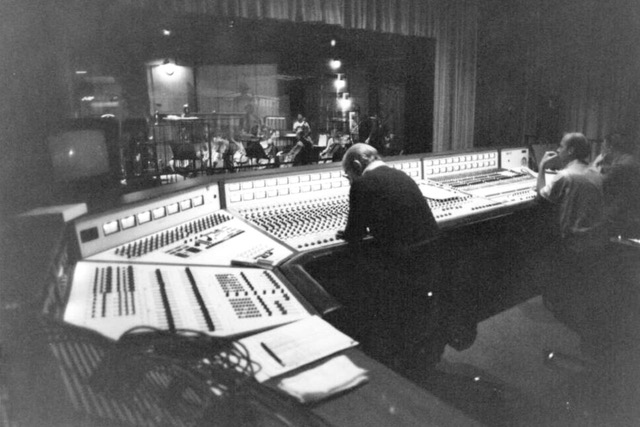
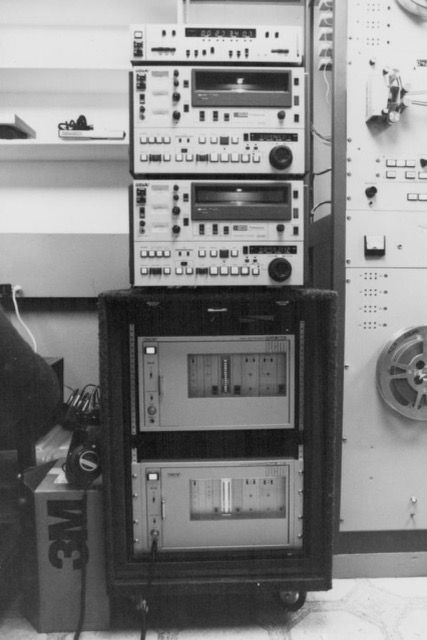
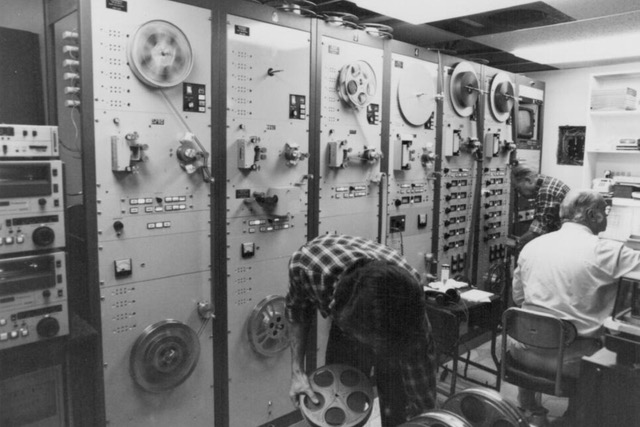
So for the original 1982 album, while “Three Million Light Years From Home” and “E.T. Phone Home” were specifically edited for album use from the main scoring sessions, “Adventure on Earth” followed a different path. Can you tell us how that track came to be?
Bruce says that they ran out of time to do digital editing, which was sort of slow and laborious in those days, so they just mixed down the analog dubbing units for “Adventure on Earth.” That’s why it matches the film and you could hear the edits. There was a “B stem” with the trumpet overlay that was lined up with those units, and while it had been dialed out for the film, it was kept in for the album. I did clean up the clunky analog edits a bit for our new master.
Well, that certainly explains why the album track is an exact match to the film version except for that one spot! Speaking of the finale to the film, the story has been told many times how Spielberg suggested turning the picture off at the recording sessions, willing to re-edit it later to match the best recording of the music. Since you had access to every take of every cue, can you tell us what it was like experiencing these cues evolve, and also which parts of the 15 minute sequence were done this way?
They did that for “The Bike Chase” and “The Departure.”“The Rescue” was done to the picture. “The Bike Chase” was the very first cue recorded and there wasn’t anything to experience on the sessions because they put down one take and then decided to turn off the film and do it “wild.” They did three takes and then used two of them to cut together the best performance, and then the film was conformed to that. On the alternate version of “The Departure,” which is largely comprised of takes heard on the previous two releases, you can hear how the tempo feels a bit inconsistent and is very different from how the final version flows. I decided to include the trumpet overlay so that the main score version and the alternate would basically give you everything you need for that finale.
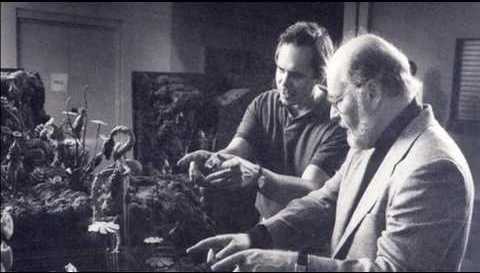
How was the original recording of “The E.T. Adventure” theme park music located, and was it easy to license for inclusion in the release?
This is a story no one would believe if you put it in a movie. When I went looking for this music, the studio came up with nothing. I told them it obviously exists since the ride is still running in Florida, and I told them I would fly to Orlando and bully my way into the control booth with a flash drive if I had to. And then Michael Duquette, who was helping with the project, said that when he went on the ride the previous summer the music was no longer used. So it looked hopeless. Then I suddenly remembered that a friend I knew back in the ‘80s moved to Florida with his family many years back and I recalled he went to work for the Universal theme park. I looked him up online to see what he did there and it turns out he is one of the top I.T. guys for the park, kind of like their Dennis Nedry.
So I contacted him out of the blue, for the first time in many years. I explained that the traditional search methods were coming up empty and he told me he would look into it. Two days later he emailed me with a barcode number. I called my contact at the studio here in L.A. and had him look it up and it came up as “E.T. Ride Japan.” It was one of seven boxes and he said it would be on the lot by the end of the day. I went over when it got there and in it were videotapes for various components for the ride, like Steven’s introduction and so on, and almost at the bottom of the box was a small 1/4” tape that said “Botanicus Theme.” Now, likely this was a dub made in Florida when the ride opened, which was then sent to Japan, so we don’t know where the original masters are, but I was satisfied enough that this was found. Honest to God, that’s how it happened. It was easy to license for the release because Universal Studios owns it outright. So it was no different from putting out any previously unreleased track.
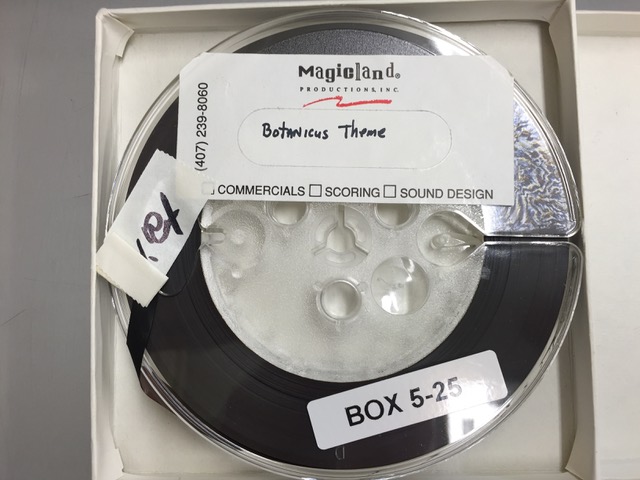
When rounding out the second disc with alternate takes of various cues, how did you determine which to include? Did you feel any obligation to include the same alternate takes that had already been released on the 1996 or 2002 CDs?
I went through the ’96 and ’02 releases thoroughly as well as the isolated music track from the LaserDisc. Basically, and to my great surprise, none of them were accurate. Even the previously unreleased cue “The Closet” used the incorrect take on the LaserDisc. So in constructing the alternates I went with what sounded the “most alternate,” if that makes sense. But there were also some different passages that we’d never heard before that I worked in. Apart from deferring to some of the incorrect takes that have been released before for the bonus section, I basically assembled this album as I would have if the previous versions hadn’t been done.
So once the program was finalized, how did you and Bruce finish everything up?
I took the data to Bruce’s studio and he did the stereo mixdowns. We worked together until it was right and then I took the finished files and did the final mastering. We work very well together and he has taught me a lot. It’s always fun and satisfying to work with him.
The new cover art is gorgeous, and I’ve seen people asking online if posters would be made available of it. What is it’s origin?
The art was my idea and Jim Titus created it. Mike Duquette will be covering it in detail for his website The Second Disc. La-La Land was able to make a deal for a limited run of posters with Mondo as a Mondocon exclusive. I don’t know if we’ll be able to do anything further right away, unfortunately. The new art was basically a pipe dream that we took a gamble on and it happened to get to Mr. Spielberg at the right time and he approved it. I wanted to see if we could go in a different direction by not showing the creature (as that’s been done a lot lately) and coming up with an image that brought back the mystery and that was relatable. Also something that made you instantly think of the music or want to listen to it. A lot of the inspiration for this came from attending the live-to-picture concerts and experiencing the movie with an audience again. It was just a feeling that part of the reason why the movie resonates today is that there is a longing for the more innocent time in which it was released. I wanted to see if we could come up with an image that captured that. You know exactly what movie it represents, but it might get you to think about other aspects of the story besides the alien. The key art with the touching hands and the bike over the moon are so iconic and familiar that there may now be a tendency to just look past them. Sometimes you need something new in order to rediscover the familiar. It was just an instinct I had and something I wanted to go for, and I’m very happy that it worked out.
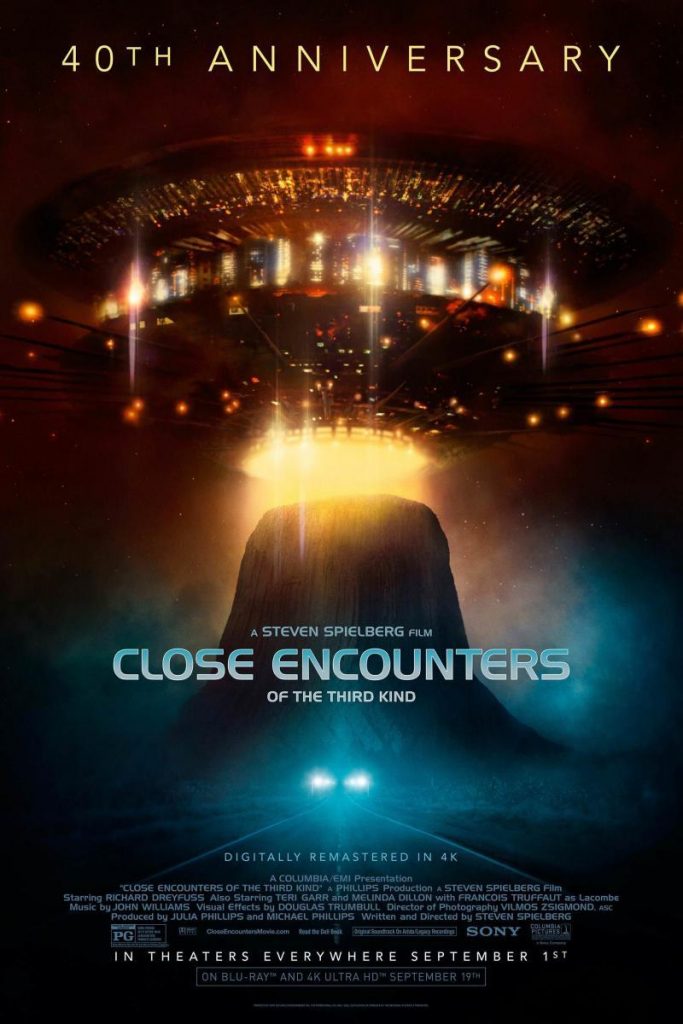
We already know your next Williams/Spielberg expanded CD release – Close Encounters of the Third Kind, coming soon from La-La Land Records. What can you tell us about this release?
Well, you asked me earlier about chronological assembly and interestingly Close Encounters is one where we’re departing from that a bit, although it will be possible to create one in a playlist. There was a lot of conversation about it because as part of working on the score I also got involved in the work on the film itself for the restoration as well as conversations about doing it in concert, which are still going on. I don’t want to steal any thunder from E.T. but I’m very excited about this one. I’ve taken a bit of a gamble with it assembly-wise, but the Maestro cares a lot about this score and he really liked what I proposed and I hope that the fans will embrace how I approached it. It really is a masterpiece and functions differently from almost any other film score. For that reason I wanted to see if I could free it from the movie a bit and work as a purely musical experience. But I wanted to make sure that listeners could also work with it and personalize it. I liken it to Roy Neary working with the mountainous shape until he feels he gets it “right.”
That sounds exciting to me! At the end of the Jurassic Park podcast, you advised John Williams fans to “save some money” for upcoming releases; were you just referring to E.T. and Close Encounters, or are there more releases around the corner as well?
I didn’t mean to imply that a flood of releases were imminent, but rather that it would be good to set aside a little nest egg so that the funds would be there for whenever releases came along. However, at that time I said that I knew that Stanley & Iris was happening, but there were also one or two others I thought might be out this year but aren’t yet. E.T. and Close Encounters really took over my life this year and I’m not complaining; they are two of my favorites. But there are just so many things you can put into the in-box with Williams or Spielberg when they’ve got so many projects going. The record labels can get overwhelmed as well and sometimes these things take more time than we’d like them to. E.T. was actually supposed to be out in June and then Close Encounters in September, but both got delayed. I’ve got some huge non-Williams releases coming up as well. Short answer: yes, there is more to come.
Many people have observed that Jaws, Close Encounters, E.T., Jurassic Park, and Home Alone all have currently touring Live to Projection concerts as well as recent CD score expansions. Does this mean we can expect CD expansions of other currently touring Live to Projection concerts (Harry Potter, Star Wars, Raiders of the Lost Ark), or – conversely – live concerts of recent CD expansions (1941, The Lost World, A.I.)?
I doubt that either The Lost World or A.I. would be considered enough of a draw to mount in concert. As for expansions, as usual I’m not at liberty to discuss what’s coming. As it is we’ve broken from the standard pattern by announcing that Close Encounters is coming soon, but that seemed to be the right thing to do given all the 40th anniversary activity and the successful reissue.
The Jaws concerts feature music restored that went unused in the original theatrical cut. How did that come to be?
That was my idea because the score was so short. So I made demonstration clips for Williams and Spielberg to look at and it helped to add another 5 minutes of music to the evening. I also designed the Intermission music utilizing part of an alternate cue. It was never considered to put in the music for Quint’s death, but I did offer the first part of “Blown to Bits” and when they saw it, John told Steven that he was right to take that out. I was supposed to be at the premiere, as you know, but had to cancel the trip due to an overload of work at the time. So now I have another concert to catch up on, but I heard it was great in Boston.
It was one of my favorite Live To Projection concerts I’ve been to, and the restored music really made it extra special! One last question for you: 2017 is notably not only E.T.’s 35th Anniversary and Close Encounters’ 40th, but the 40th Anniversary of Star Wars as well. Can you tell us if Disney will be celebrating the anniversary with a new expanded score presentation?
No expanded score presentations this year. We’ve got four of the films live in concert plus a new episode scored by John Williams coming imminently, so the 40th anniversary seems quite celebratory to me. Disney has hit the reset button by getting the original albums back into the marketplace, which I think is the right idea for now. There won’t be anything expanded coming just yet.
Makes sense to me. On behalf of all us “students” everywhere, thanks for your continuing work on these releases, and thanks so much for answering these questions today.
Thanks, Jason. It is a pleasure, as always. Now back to work!
Mike Matessino is a prominent mixer / editor, soundtrack producer and film music preservationist. Visit his website for a complete list of projects he has worked on: www.mikematessino.com
Jason LeBlanc can be reached on the JWFan forums
Special Thanks to JWFan member thx99 for the artwork

